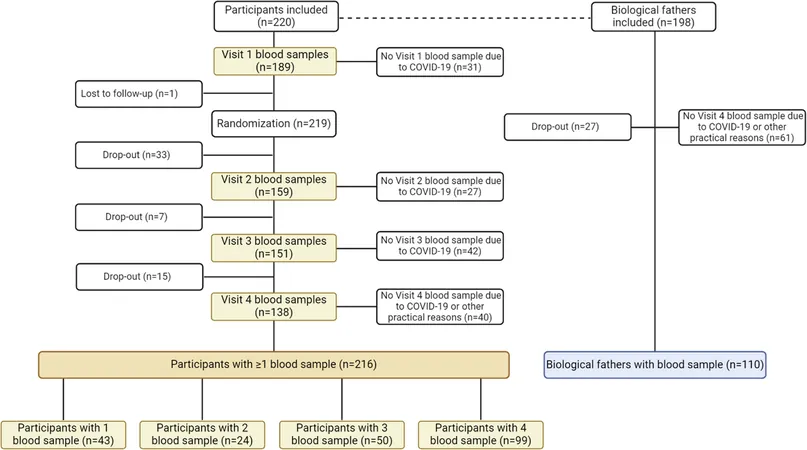
Alarming Findings on PFAS Levels in Pregnant Women: How Your Partner's Exposure Could Affect You!
2025-04-02
Author: Yu
Introduction
In recent years, there has been growing evidence about the dangers of Per- and Polyfluoroalkyl Substances (PFAS)—a group of synthetic chemicals often used in consumer products for their water-repellent properties. These substances have been linked to a myriad of health issues, creating urgent concerns about exposure, particularly among pregnant women. A new study from Denmark delves into the serum concentrations of PFAS in pregnant women and provides significant insights into how these levels change throughout pregnancy, their correlations with partners, and their relationship to physical activity.
Study Overview
The findings stem from the FitMum study, which ran from 2018 to 2021 and included 216 healthy pregnant women and their partners. Non-fasting blood samples from mothers were collected multiple times throughout their pregnancies, allowing researchers to track the levels of 15 different PFAS compounds in their systems using advanced mass spectrometry techniques. They also measured other relevant health indicators such as cholesterol and triglyceride levels, providing a comprehensive picture of the participants' health throughout the pregnancy.
Results and Trends
The study uncovered several key findings:
1. PFAS Detection: The most concerning PFAS detected in the mothers' serum were PFOS, PFOA, PFHxS, PFNA, PFDA, and PFUnDA. Notably, partner concentrations were found to be significantly higher—by 3% to 145%—compared to the mothers’ levels in most instances.
2. Decrease During Pregnancy: Alarmingly, all PFAS levels in mothers decreased significantly during pregnancy. For instance, PFOS concentrations dropped by around 23.1% from the start of the pregnancy to delivery. This decline in PFAS levels is crucial, especially considering the health risks that these substances pose during this sensitive time.
3. Correlations with Partners: The investigation revealed a strong correlation between PFAS levels in partners and mothers living in the same household, indicating shared environmental sources of exposure, potentially through dietary intake or household items.
4. Associations With Cholesterol: Surprisingly, higher PFAS concentrations were associated with elevated levels of high-density lipoprotein cholesterol (HDL-C). However, no significant links were found between physical activity levels and maternal PFAS concentrations, raising intriguing questions about how lifestyle factors influence exposure and health during pregnancy.
Significance of Findings
These findings not only highlight the concerning prevalence of PFAS in pregnant women but also raise critical awareness regarding household exposure. The health implications are particularly relevant, as studies have linked PFAS exposure to reproductive and developmental issues, neurotoxicity, and even cancer.
The fact that partners show higher concentrations of PFAS in their serum points to the possibility of consistent exposure from shared environments. This could be alarming news for couples planning to conceive, as it emphasizes the need for greater awareness of potentially harmful household products.
Conclusion and Call to Action
The evidence emerging from the FitMum study underscores the urgent need for further research into PFAS exposure during pregnancy and its long-term health consequences. Pregnant women and their partners should be informed about PFAS, leading to informed choices about the products they use in their daily lives.
As regulations around PFAS continue to evolve—driven by increasing recognition of the health threats posed by these substances—it's essential for both individuals and families to be proactive in mitigating exposure. This could mean choosing alternative products, advocating for policy changes, and participating in awareness campaigns.
In an era where environmental health cannot be overlooked, the questions raised by this study are worth paying attention to. The health of future generations may depend on it!



 Brasil (PT)
Brasil (PT)
 Canada (EN)
Canada (EN)
 Chile (ES)
Chile (ES)
 Česko (CS)
Česko (CS)
 대한민국 (KO)
대한민국 (KO)
 España (ES)
España (ES)
 France (FR)
France (FR)
 Hong Kong (EN)
Hong Kong (EN)
 Italia (IT)
Italia (IT)
 日本 (JA)
日本 (JA)
 Magyarország (HU)
Magyarország (HU)
 Norge (NO)
Norge (NO)
 Polska (PL)
Polska (PL)
 Schweiz (DE)
Schweiz (DE)
 Singapore (EN)
Singapore (EN)
 Sverige (SV)
Sverige (SV)
 Suomi (FI)
Suomi (FI)
 Türkiye (TR)
Türkiye (TR)
 الإمارات العربية المتحدة (AR)
الإمارات العربية المتحدة (AR)